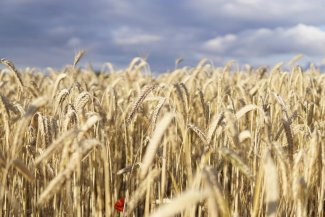Production and export of food from Ukraine during the war with Russia

Despite the war that has been raging for more than two months, Ukraine has managed to start this year’s sowing campaign, although estimates are that the areas cultivated will be up to 30% smaller than in 2021. A fuel shortage could also be a problem during this year’s harvest. Nor is it clear what the harvest will look like in the occupied territories. Currently, there is no risk of a food deficit, as the country has very significant grain stocks (about 20 million tonnes), exceeding the annual consumption for some species. However, problems may arise in this regard in the Russian-occupied areas as the occupiers have been confiscating grain. The biggest challenge for Kyiv remains the blockade of ports on the Black Sea and the Sea of Azov, through which the vast majority of food (especially grains and vegetable oils) has been exported. Although the infrastructure of the most important of these ports has not suffered, it seems unlikely that they will resume operations in the coming months, even if a ceasefire was to be reached. This is because Moscow will be keen to continue the economic pressure. Ukraine will thus be forced to continue using alternative supply routes via EU countries, particularly Poland and Romania.
Agricultural production and the sowing campaign
Agriculture is one of the most important branches of Ukraine’s economy, and it is one of the few sectors that has seen continuous growth in recent years.[1] In 2021, the country recorded the largest grain harvest in its history, 86 million tonnes (an increase of 32.5% over the previous year). For the purpose of comparison, this a figure is almost three times higher than in Poland. The bulk of the harvest was made up of maize (42.1 million tonnes, +39%), wheat (32.2 million tonnes, +29.2%) and barley (9.4 million tonnes, +23.6%), with other crops being marginal. The oilseed crop amounted to 22.8 million tonnes, including 16.4 million tonnes (+25%) of sunflower seeds, 2.9 million tonnes (+14.9%) of rapeseed, and 3.5 million tonnes (+24.9%) of soybeans.
The main problems caused by the Russian aggression include difficulties with the sowing campaign. Its first phase took place last autumn, when 7.7 million ha of winter cereals (wheat, barley) and 1.2 million ha of winter rape were sown. Now the biggest challenge is to carry out agricultural work under war conditions. Since the beginning of March, the authorities in Kyiv have repeatedly called for the campaign to begin wherever possible, including the occupied territories. So far, the districts responsible for most of Ukraine’s agricultural production (located in the central, northern and eastern parts of the country) have not been occupied by the Russians, or were occupied only temporarily. However, it is difficult to predict how the situation will develop in the coming weeks. Some farmers and agribusinesses which find themselves under an almost total export blockade (see below) do not have the means to start sowing. To help them, the government has introduced interest compensation for loans intended for agricultural activities amounting to up to $1.7 million per company. By the end of April, banks had given industry players loans totalling 15 billion hryvnias (about $500 million).[2]
In mid-March, the Ministry of Agriculture estimated that farmers and businesses have 78% of the seeds they need, 84% of fertilisers, and 55% of crop protection products.[3] However, there is a problem with fuel supplies. Before the war, Ukraine produced about 50% of the gasoline it needed, 15% of the diesel and 20% of the LPG. About two-thirds of gasoline and diesel imports came from Belarus and Russia, but these supplies ceased after the invasion began. In addition, the aggressor’s troops began regularly destroying oil bases throughout the country and fired on the only functioning refinery (in Kremenchuk), causing it to halt production. Kyiv has begun importing fuel from EU countries, but the damage to the infrastructure makes logistics difficult. Nevertheless, there are currently no reports of fuel shortages for agriculture, although there are some short-term local shortages. It remains uncertain whether a relatively stable supply for the sector can be maintained in the coming months.
The ministry forecasts that the area sown for the spring crops will shrink by 20.5%, from 16.9 to 13.4 million hectares,[4] although there are also opinions that the total cultivated area could be as much as 25-30% smaller than last year. However, these estimates are difficult to assess. In the areas temporarily occupied by Russian troops (large parts of the Kyiv, Chernihiv and Sumy regions) and those where military operations took place there are often unexploded mines or ordnance , which makes field work difficult (some tractor drivers have already died in such circumstances). It is not known how the sowing campaign in the occupied territories is proceeding. There are more and more reports of agricultural produce being confiscated and exported to Russia; according to the Ministry of Agriculture of Ukraine, up to several hundred thousand tonnes of grain may have been stolen in this way.[5]
The Ministry of Agriculture recommends a change in the structure of the sowing programme, namely the introduction of species which give relatively lower yields volume-wise. Some companies have started sowing crops that yield 2–3 tonnes per hectare, such as soya, sunflower and rapeseed, instead of maize, whose yield averages 8–10 tonnes per hectare. Their lower fertility should make export logistics easier. It is impossible to assess the scale of this phenomenon as yet, but it can be assumed that this year’s maize harvest will be significantly smaller. In addition, the ministry has advised farmers to plant species that are cheaper to grow, such as spring wheat and spring barley.
Exports and logistical challenges
Ukraine is one of the world’s leading food traders: it accounts for half of global sunflower oil exports, 16% of corn and 10% of wheat, and it is also a major supplier of barley and rapeseed. The sector’s exports are also crucial to the economy, with a value of $27.7 billion in 2021, accounting for 40.7% of total sales to foreign markets. The most important commodity items were cereals ($12.3 billion) and vegetable oils, mainly sunflower ($7 billion). Ukrainian cereals are primarily sent to countries in Southeast Asia, the Middle East and North Africa. Among the fifteen largest importers there are only three EU countries, which are located quite far from Ukraine’s borders (Spain, the Netherlands and Italy).
Chart 1. The biggest recipients of grain from Ukraine in 2021

Source: authors’ calculations based on data from the Ukrainian State Statistics Committee.
Before the war, about two-thirds of exports were carried by sea. With regard to agricultural production, this indicator was even higher: for cereals it was 99%, and for vegetable oils 91% (6% was sent by road, 3% – by rail). In Q4 2021, trans-shipment at ports was 5–6 million tonnes per month for cereals and 500,000–600,000 tonnes for vegetable oils. At the beginning of the aggression, Ukraine’s ports on the Black Sea and the Sea of Azov were blockaded. In the course of hostilities, the country lost control of four of them, while the infrastructure of the others remained intact or suffered only minor damage. In 2021, the ports in and around Odesa (in Chernomorsk and Yuzhne) and Mykolaiv were the most important, while those currently under occupation – in Mariupol, Berdyansk and Kherson – played a much smaller role.
Chart 2. Grain exports from Ukrainian ports in 2021

Source: authors’ calculations based on data from the Administration of Sea Ports of Ukraine.
The Russian naval blockade has led to a collapse of Ukraine’s foreign trade. According to the Ministry of the Economy, 5.97 million tonnes of goods worth $2.7 billion were exported in March, compared to 13.1 million tonnes worth $5.3 billion in February. Exports of grains and oils were particularly challenging, with 1.1 million tonnes of corn, 309,000 tonnes of wheat and 118,000 tonnes of sunflower oil sold abroad in March, barely a quarter of the figure in February. These figures are still surprisingly high, as industry experts have previously estimated that a maximum of only 500,000 tonnes of grain per month could be exported by rail and road. On the other hand, it is uncertain how reliable these figures are, as the agriculture minister Mykola Solskyi said in an interview on 14 April that agricultural exports in March amounted to just 200,000 tonnes. According to the ministry, 1.1 million tonnes of cereals were sold abroad in April.[6]
The Ukrainian government is intensively searching for alternative export routes for its agricultural products, especially grain. Kyiv has been considering a possible connection via Poland to the Baltic ports (mainly Gdańsk, but it is also holding talks with Lithuania and Estonia on using their infrastructure) and to Romania as the most promising. The first ship carrying Ukrainian grain set sail from Constanța on 29 April.[7] On 23 April, Poland and Ukraine signed a memorandum on enhancing cooperation in the field of rail transit; this document envisages the establishment of a joint railroad company that will operate connections to Western markets.
Another problem is the very large grain reserves in the country. According to the Ministry of Agriculture, these amount to 6 million tonnes of wheat (with an annual demand of 8 million tonnes) and 15 million tonnes of corn (7 million tonnes are consumed annually). On the one hand this is positive news, because it means that Ukraine is not threatened by a food deficit (although that could still occur in the occupied territories and areas where military operations are taking place, and difficulties with supply remain). On the other hand, even if we assume that 1.4 million tonnes were exported in March, it will take many months simply to export the current stock. In the next quarter, the harvest will start and tens of millions of tonnes of grain will have to be stored. According to the Ukrainian government, the country does not have sufficient infrastructure to store such volumes of grain. Besides, some elevators are not adapted to store more than 2–3 months of grain. This is especially true for the ports, which currently hold 1.3 million tonnes of grain and oil (or 4.5 million tonnes of grain alone, according to other reports).[8]
Prospects
In the next few months, the development of production and export of agricultural crops will directly depend on the situation on the front. Theoretically, there could be a ceasefire or the signing of some document along the lines of the Minsk agreements of 2014 and 2015 maintaining the positions currently held. If one of its conditions was to give Kyiv access to its ports, the trade situation could return to the pre-war status (although clearing mines from the sea routes will take up to two months). A variant in which the aggressor maintains the blockade even in the event of a ceasefire cannot be ruled out, as Moscow will want to continue its economic pressure. The worst scenario would be Russia occupying the entire coastal strip and completely cutting off Ukraine’s access to the sea. This would mean that exports would have to be redirected entirely via EU countries, and would necessitate a streamlining of logistics (including the improvement of the infrastructure on the borders) and a range of new investments, including the construction of trans-shipment terminals for goods which have not previously been transported through the EU (e.g. cereals).
[1] For more on Ukrainian agriculture see S. Matuszak, The breadbasket of the world? Agricultural development in Ukraine, OSW, Warsaw 2021, osw.waw.pl.
[2] ‘Банки видали аграріям пільгових кредитів для проведення посівної на 15 мільярдів’, Бізнес Цензор, 29 April 2022, biz.censor.net.
[3] ‘Україна забезпечена добривами до посівної на 84%’, Interfax-Україна, 14 March 2022, nterfax.com.ua.
[4] ‘Мінагрополітики визначило рекомендовані культури для аграріїв’, Бізнес Цензор, 4 April 2022, biz.censor.net.
[5] ‘Росіяни вивезли з України декілька сот тонн зерна, – Висоцький’, idem, 1 May 2022.
[6] О. Павлиш, Д. Дєнков, ‘Аграрний експорт оживає: у квітні з України вивезли у 5 разів більше сільгосппродукції’, Економічна правда, 3 May 2022, epravda.com.ua.
[7] ‘Перше судно з українським зерном завантажили для експорту в порту Румунії’, Європейська правда, 29 April 2022, eurointegration.com.ua.
[8] ‘В українських портах заблоковано майже 4,5 мільйона тонн зерна, – ООН’, Бізнес Цензор, 2 May 2022, biz.censor.net.




